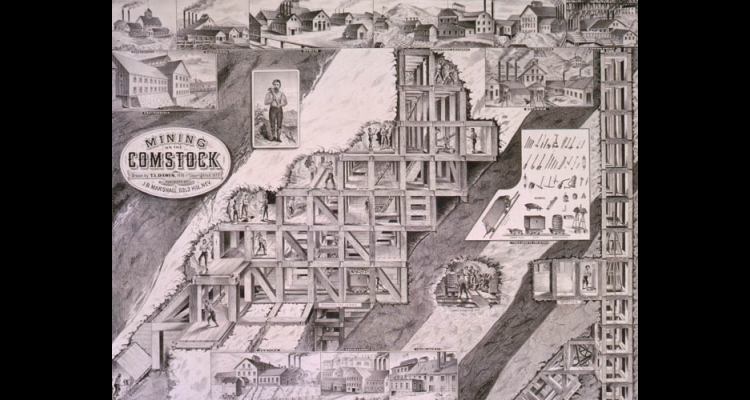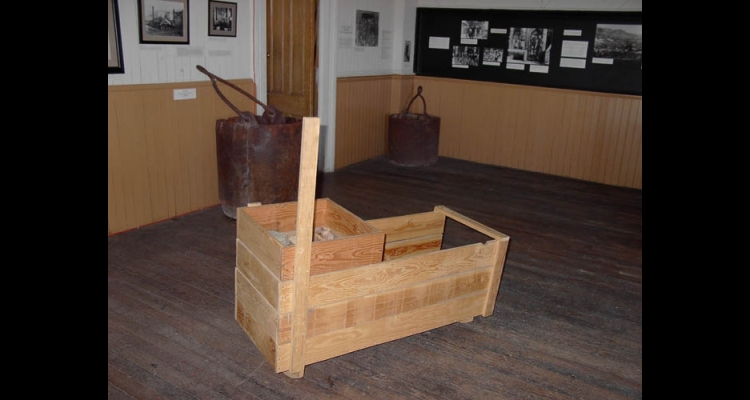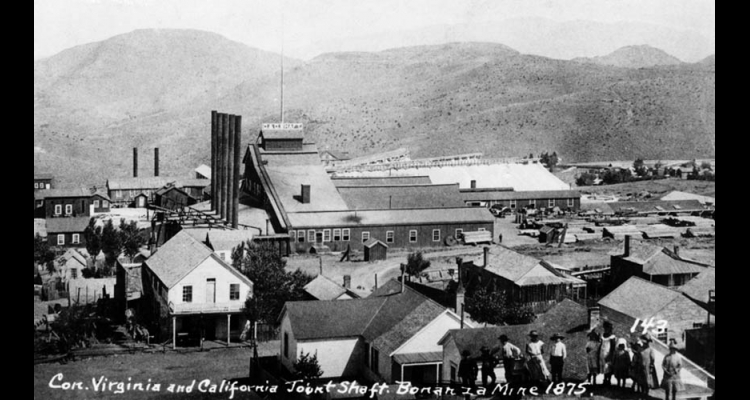Mining Technology in the Nineteenth Century
Mining technology consists of the tools, methods, and knowledge used to locate, extract, and process mineral and metal deposits in the earth. The methods used to locate ore bodies range from on-the-ground reconnaissance by prospectors to remote sensing techniques such as satellite imagery. Mine excavations take place either on the surface or underground.
The earliest mines in Nevada exposed and removed placer (water-transported gravels) or hardrock deposits with surface excavations. They excavated with simple hand tools such as picks and shovels and dug open "glory holes" or pits to reach the ore body. Placer miners sometimes used high-pressure water sprays (hydraulic mining) to excavate gravel deposits. To facilitate water conveyance, California Gold Rush miners from China introduced Chinese pumps, bucket bailers on an endless chain driven by a waterwheel.
By the end of the nineteenth century, placer miners in Nevada employed floating bucket dredges. Placer mining in the Round Mountain and Manhattan districts, for example, used a variety of surface excavation technologies ranging from hydraulic monitors to floating bucket dredges during the first half of the twentieth century. The introduction of open pit mining with power shovels first developed in the Mesabi Iron Range in Minnesota and later at the Bingham pit in Utah in the late nineteenth century, greatly changed the scale of surface mining in the twentieth century.
Underground mining took place in both hardrock and placer deposits and used excavation, support, hoisting, ventilation, and drainage technologies. Early miners dug shallow shafts to reach the ore body, which they then followed to create "rathole" or unplanned underground workings. Engineer-designed or planned underground workings became more typical by the end of the nineteenth century.
Early excavations used hand drills and black powder. The late 1860s saw the invention of dynamite and the mechanical rock drill. They supported underground workings with wooden timbers, the best known of which is the "square-set timbering" invented in 1860 on the Comstock, and unexcavated rock pillars or the "shrinkage" system by the beginning of the twentieth century. Early miners hand carried ore or used simple machines such as windlasses, whims, or small steam engines. Deep mining on the Comstock in the 1860s and 1870s introduced new hoisting technologies such as large steam engines and high-speed cages. A system of air passages connected to the outside ventilated some mines and others used hand bellows or engine-powered fans. Early mines drained underground workings with tunnels or bucket bailers. Deep mining on the Comstock introduced large, steam-powered Cornish pumps.
Ore processing technologies extract economically valuable minerals and metals. They include the collection of naturally occurring metals and minerals (e.g., placer gold or lode silver), crushing and grinding ores, mechanical concentration of ores containing metals and minerals, and breaking down the ores with chemical, heat, and electrical processes. "Free milling" ores require the simplest processing technologies.
Placer miners used simple tools such as pans and bateas, rockers, sluices, Long Toms, and dry washers to separate free metals from gravels. They sometimes used mercury, which forms an amalgam with small particles of gold and silver. Miners used mechanical crushing and grinding machines to break up ores for further processing. Early miners used Mexican arrastras or stamp mills, which reached their peak in the late nineteenth century, to crush ores into sand-size particles. Before going to stamp mills, ores often went through rock crushers, which were like nutcrackers.
The development of cyanide milling at the end of the nineteenth century required grinding into smaller and more uniform sized particles using Chilean mills, ball mills, and tube mills. After crushing or grinding, miners often used vibrating or shaking machines called concentrators (e.g., jigs, buddles, vanners, Embrey tables, and Wilfley tables) to separate heavier metal-bearing ores from gangue. Flotation, which used "frothing" machines to mix air bubbles with oil and finely ground ore, emerged by the early twentieth century to do the same thing. Miners then shipped the resulting concentrates to smelters for further processing.
Miners used chemicals, heat, and electricity to process more complex metal and mineral compounds. Silver, for example, often occurs in the compound argentite (silver sulfide) or in lead compounds. Historically, the key chemical processes included amalgamation with mercury and leaching in a solution of chlorine, sodium or calcium hyposulfite (lixiviation), or cyanide. Early Nevada miners mostly used amalgamation. The method dates back to medieval Europe and developed further in the mines of Spanish Colonial America. Amalgamation methods include passing crushed ore over mercury-coated copper plates and tables, patio yards, and the Washoe pan process, which used mechanical pans and steam heat to replicate patio yards. The Reese River variant of the pan process roasted ores with salt to form silver chloride before amalgamating in Washoe pans.
Leaching with chlorine began in Saxony, Germany, where Carl Frederick Plattner developed the Freiberg barrel chlorination process in 1858. Some early mills in Nevada (e.g., the Ophir Mill in Washoe Valley) used this process, but it rapidly lost out to the cheaper Washoe pan. Chlorine leaching, however, expanded into many areas of the American West and elsewhere during the nineteenth century and was used in some Nevada mills in the late twentieth century. Lixiviation mills, developed in the 1880s, leached complex ores with a solution of sodium or calcium hyposulfite and occurred throughout the West in the late nineteenth century. The development of the cyanide leaching process in Scotland and New Zealand in the late 1880s, however, revolutionized ore processing and spread rapidly throughout Nevada by the 1890s. Cyanide mills dominated the industry for most of the twentieth century.
Another common method for separating metals and minerals from rock involved the application of heat. Smelting technologies date back at least five thousand years and include both bloom and blast furnaces driven by air currents originating in wind or air drafts, bellows, and machines. In Nevada, experimentation with smelting lead-silver ores took place in the White Pine district in the late 1860s and ultimately led to the emergence of Eureka as a world-class smelting center in the 1870s and 1880s.
Article Locations
Related Articles
None at this time.




